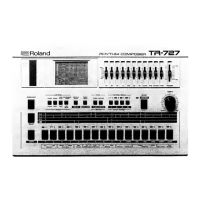Outline
of the
TR-727
The Rhythm
Composer
TR-727
is a fully
program-
mable
rhythm machine
which
allows
you
to
pro-
gram 4
Rhythm
Tracks
or
tunes
(altogether
998
bars)
from up to
64
kinds
of
user-dreated
Rhythm
Patterns.
Each of the
15
digital
drum
voices
is
extremely
realistic and has a
separate
output
jack for individ-
ual
mixing,
echo or
equalizer.
An
optional memory
cartridge
plugs
directly
into
the
Composer for
instantaneous
loading
and
saving,
expanding the
memory
capacity
by
three
times.
A
Display
window helps
your operation to
great
extent.
MIDI
Bus on the rear panel
interfaces
with other
MIDI
devices
to
allow
control of several instruments.
Flam
(Grace-note)
and Shuffle
can
be added for
greater
variety and
realism.
Now
we'll find
our way around the important
controls
before
creating
and storing
('writing') our
own
rhythm tracks. With
any
computer
keyboard,
the same
key may
do several
different
jobs depend-
ing on
how it is used. The
Composer,
which
is a
type
of
computer,
does this
also.
When switched on,
the Composer
automatically
selects (or 'defaults' to)
Track I.
"Default"
means the
value
automatically selected
by
the
Composer
overriden
by
your command.
A Track is a
complete
tune
in rhythm,
made up
of
Patterns
strung
together
(Patterns are covered later),
and
there is
a demonstration tune written
on Track
I.
The SHIFT
Key
is
used
a
lot. It enables
many but-
tons
and keys to
perform
two
functions instead
of
just
one.
The distinction
is
clearly
marked on the
Composer:
all functions enclosed with
lines and
highlighted
are selected
while the SHIFT Key
is
held down.
All
other
functions do not
need the
SHIFT
Key.
The only exception to this rule
is
the
ENTER
Key.
The
Main Keys
numbered 1
to 16
are used
for
several
tasks:
(i) They
produce the voices
manually
when tapped.
(ii) They divide
a
bar of
music into
16
parts,
and
enable voices
to be written into any of these
parts.
(iii)
They assign the instrument
voices
in turn when
you
are writing.
(iv)
They take care of
all the "housekeeping"
in-
volved in
editing Rhythm Patterns and
Track,
such
as
delete,
insert and
copy.
(v) They
set the
Accent on the major voices.
Above the
Main Keys is the scale of time values
with
a red LED beside each
to
indicate which is in opera-
tion. These indicate whether
you
are
operating
in
2/4, 3/4, 4/4,
6/8
or
multiples of these times.
Default value
is
4/4,
other
times
are set with
the
SCALE button.
Special times such
as
5/4,
7/4 or any
other can be
set with the LAST STEP
button.
Mixed times which
change
each bar can also
be set up.
We use the CLEAR
button
to
erase
rhythm
patterns
we want
to
write
over,
the FLAM button
for adding
Flam or
'grace
notes'
ahead of the main beat,
and
INSTRUMENT
SELECT for selecting each
voice
in turn
when writing
Patterns.
Finally, don't
worry
if
you can't
get an immediate
response
from
these
controls;
sometimes they
operate
only
under
special circumstances
to protect
your
data.
A
full
explanation of all controls
follows
in
this
Manual.

